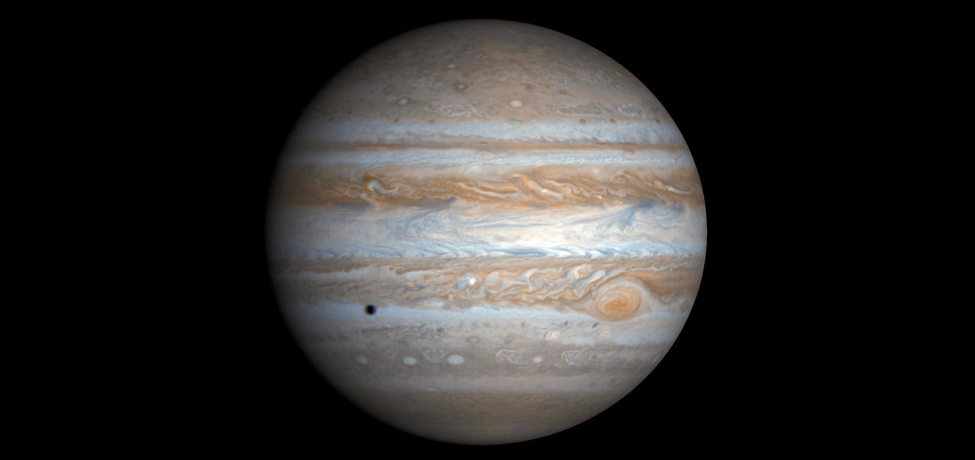| << Chapter < Page | Chapter >> Page > |
By the end of this section, you will be able to:
The giant planets hold most of the mass in our planetary system. Jupiter alone exceeds the mass of all the other planets combined ( [link] ). The material available to build these planets can be divided into three classes by what they are made of: “gases,” “ices,” and “rocks” (see [link] ). The “gases” are primarily hydrogen and helium, the most abundant elements in the universe. The way it is used here, the term “ices” refers to composition only and not whether a substance is actually in a solid state. “Ices” means compounds that form from the next most abundant elements: oxygen, carbon, and nitrogen. Common ices are water, methane, and ammonia, but ices may also include carbon monoxide, carbon dioxide, and others. “Rocks” are even less abundant than ices, and include everything else: magnesium, silicon, iron, and so on.

| Abundances in the Outer Solar System | ||
|---|---|---|
| Type of Material | Name | Approximate % (by Mass) |
| Gas | Hydrogen (H 2 ) | 75 |
| Gas | Helium (He) | 24 |
| Ice | Water (H 2 O) | 0.6 |
| Ice | Methane (CH 4 ) | 0.4 |
| Ice | Ammonia (NH 3 ) | 0.1 |
| Rock | Magnesium (Mg), iron (Fe), silicon (Si) | 0.3 |
In the outer solar system, gases dominate the two largest planets, Jupiter and Saturn , hence their nickname “gas giants.” Uranus and Neptune are called “ice giants” because their interiors contain far more of the “ice” component than their larger cousins. The chemistry for all four giant planet atmospheres is dominated by hydrogen. This hydrogen caused the chemistry of the outer solar system to become reducing, meaning that other elements tend to combine with hydrogen first. In the early solar system, most of the oxygen combined with hydrogen to make H 2 O and was thus unavailable to form the kinds of oxidized compounds with other elements that are more familiar to us in the inner solar system (such as CO 2 ). As a result, the compounds detected in the atmosphere of the giant planets are mostly hydrogen-based gases such as methane (CH 4 ) and ammonia (NH 3 ), or more complex hydrocarbons (combinations of hydrogen and carbon) such as ethane (C 2 H 6 ) and acetylene (C 2 H 2 ).
Eight spacecraft, seven from the United States and one from Europe, have penetrated beyond the asteroid belt into the realm of the giants. [link] summarizes the spacecraft missions to the outer solar system.
| Missions to the Giant Planets | |||
|---|---|---|---|
| Planet | Spacecraft Both the Ulysses and the New Horizons spacecraft (designed to study the Sun and Pluto, respectively) flew past Jupiter for a gravity boost (gaining energy by “stealing” a little bit from the giant planet’s rotation). | Encounter Date | Type |
| Jupiter | Pioneer 10 | December 1973 | Flyby |
| Pioneer 11 | December 1974 | Flyby | |
| Voyager 1 | March 1979 | Flyby | |
| Voyager 2 | July 1979 | Flyby | |
| Ulysses | February 1992 | Flyby during gravity assist | |
| Galileo | December 1995 | Orbiter and probe | |
| Cassini | December 2002 | Flyby | |
| New Horizons | February 2007 | Flyby during gravity assist | |
| Juno | July 2016 | Orbiter | |
| Saturn | Pioneer 11 | September 1979 | Flyby |
| Voyager 1 | November 1980 | Flyby | |
| Voyager 2 | August 1981 | Flyby | |
| Cassini | July 2004 (Saturn orbit injection 2000) | Orbiter | |
| Uranus | Voyager 2 | January 1986 | Flyby |
| Neptune | Voyager 2 | August 1989 | Flyby |

Notification Switch
Would you like to follow the 'Astronomy' conversation and receive update notifications?